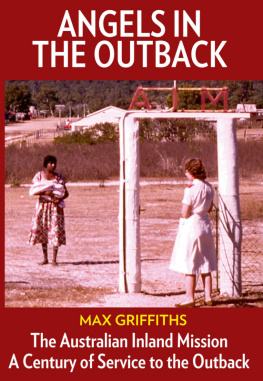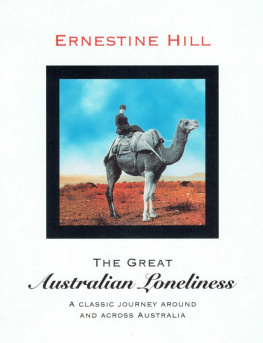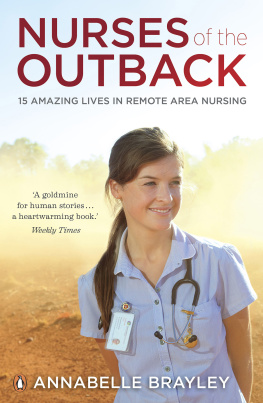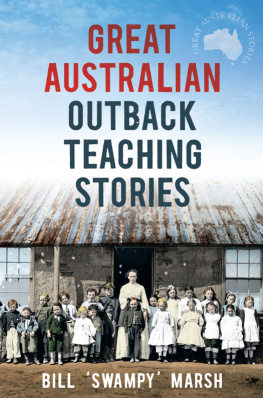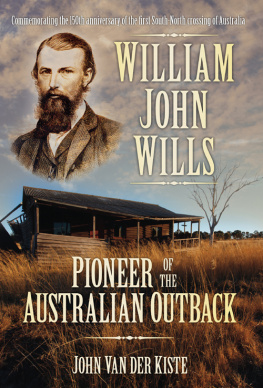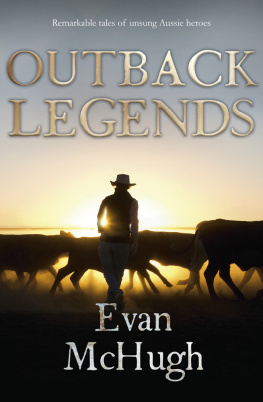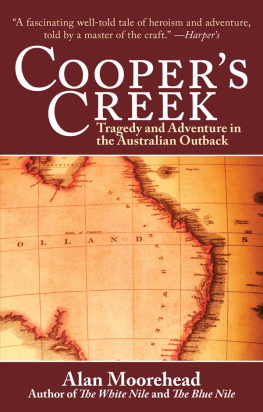ANGELS IN THE OUTBACK
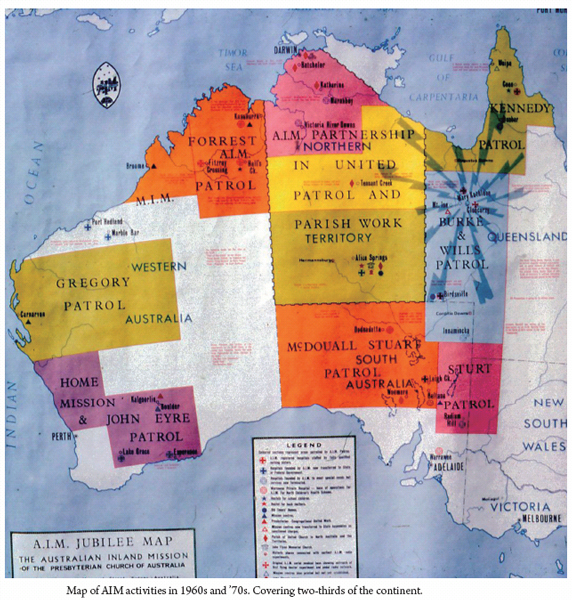
ANGELS IN THE
OUTBACK
MAX GRIFFITHS
ROSENBERG
First published in Australia in 2012
by Rosenberg Publishing Pty Ltd
PO Box 6125, Dural Delivery Centre NSW 2158
Phone: 61 2 9654 1502 Fax: 61 2 9654 1338
Email:
Web: www.rosenbergpub.com.au
FB: www.facebook.com/RosenbergPublishing
Copyright Max Griffiths 2012
All rights reserved. No part of this publication may be reproduced, stored in a retrieval system, or transmitted, in any form or by any means, electronic, mechanical, photocopying, recording or otherwise, without the prior permission of the publisher in writing
National Library of Australia Cataloguing-in-Publication entry
Author: Griffiths, Max.
Title: Angels in the outback : the Australian Inland Mission : a century of service to the outback / Max Griffiths.
ISBN: 9781921719585 (pbk.)
ISBN: 9781922013590 (Ebook)
ISBN: 9781922013606 (Epub)
ISBN: 9781922013613 (mobi/Kindle)
Notes: Includes bibliographical references and index.
Subjects: Australian Inland Mission--Histor
Presbyterian Church of Australia--Missions--History
Medical care--Australia, Central--History.
Missions--Australia, Central--History.
Rural health services--Australia--History.
Social service, Rural--Australia--History.
Australia, Central--Social conditions--History.
Dewey Number: 266.5294
Cover: Warm welcome and a helping hand. Nursing sister at Coen welcomes Aboriginal mother and baby.
Printed in China by Everbest Printing Co Limited
CONTENTS
Foreword
This is a remarkable story told for the first time in all its detail and with the understanding of an insider.
Just before World War I when the Australian outback suffered with the decline of its goldmines and the hard times on its pastoral runs, a young Victorian arrived to see how he could help. The white inhabitants were few, and were rarely if ever visited by clergymen, doctors or nurses. The long-distance mailman was the most regular visitor, but the letters and newspapers he brought were sometimes weeks old. Then the biggest town of todays outback, Alice Springs, held just a few people. In Central Australia lived many Aborigines who had not met a European.
It was the Reverend John Flynn, a young Presbyterian clergyman from Victoria, who set out to ease the loneliness of many outback people. Working under the banner of his Australian Inland Mission he eventually was helped by travelling padres who held religious services where two or three people and a child or two were gathered together, and by the young nurses who opened makeshift hospitals far from the doctors surgery. The difficulties they faced are traced in this book. We see Sister Latto Bett travelling on an open trolley along one of the few outback railways, and holding up an umbrella to protect her from the intense heat. We glimpse Padre Plowman riding a camel, for it was still the main carrier in a vast arid area.
Here in the late 1920s the worlds first flying doctor service was founded. It was made possible by Flynns supporters; a young and dedicated Melbourne doctor named George Simpson; Alfred Traegar of Adelaide who devised a pedal wireless that linked outback homesteads and camps with the faraway pilot and doctor; and the engineers who managed to fit a stretcher inside the cramped cabin of the tiny Qantas aircraft of that era. Above all Flynn received financial help from two Victorians, the fundraising the Reverend J.A. Barbour and the celebrated maker of harvesting machines, H.V. McKay. Tens of thousands of other Australians, many of whom were poor, donated the money that spread this aerial network across the continent.
After Flynn died, his role as leader was taken up by Fred McKay, a North Queenslander, and then by Max Griffiths, the author of this book. The brisk revival of outback mining in the second half of the twentieth century, and the changing way of life of Aboriginal peoples, multiplied the calls on the organisation that Flynn had founded. Max Griffiths carries the story into this new era.
This book was just waiting to be written, but the records had to be scoured and sifted and selected, and the evidence weighed, and the people and the atmosphere of the times carefully brought to life. Max Griffiths took on this task, and many readers will thank him for weaving together these important strands of Australian history.
Geoffrey Blainey April 2012
Introduction: A Country Characterised by Isolation
The story of the Australian Inland Mission is one of the great sagas in the nations history. Generally associated with one person, John Flynn, Flynn of the Inland, the AIM story would be incomplete without mentioning the many men and women who were its front line soldiers in the battle against isolation in the Australian outback.
So this story is largely told through their eyes and experiences because they too fought their own personal and professional battles against isolation.
Isolation and its attendant experience of loneliness is probably the most universal disease in the world. The great Catholic saint Mother Theresa once said: The biggest disease today is not leprosy or tuberculosis, but rather the feeling of being unwanted, uncared for and deserted by everybody.
Her opinion is all the more astonishing since she lived and worked in one of the most crowded and disease-ridden cities in the world. What Mother Theresa described in such dramatic language is commonly called loneliness. The Bible makes the same comment but in a more succinct fashion. On first creating a human being God made the simple comment, It is not good for a human being to be alone.
Although loneliness can be experienced in many different situations, its harshest expression occurs when people live in total isolation from their fellow human beings. It is in this sense that we can use the word isolation to describe life in Australia from the beginning of European settlement in 1788 until well into the twentieth century. First, Australia was isolated from the rest of the world, especially from Europe from which the early settlers came. Second, the various parts of Australia were isolated from each other. The dominant reason for both these kinds of isolation was simply distance, which Professor Geoffrey Blainey graphically describes in his book The Tyranny of Distance.
However, nowhere was this isolation more glaringly obvious than in what we call the inland or the outback. Even at the beginning of the twentieth century there were huge areas of the Australian continent unknown to all except a few explorers. Communication by road or rail was non-existent and the same applied to communication by telegraph or telephone. Now familiar population centres such as Alice Springs and Mount Isa were not even mentioned on maps. Towns such as Darwin and the pearling port of Broome were only accessible by sea. Anyone wishing to travel from Melbourne to Darwin had to be prepared for a sea voyage lasting at least a fortnight. There was no national identity; only six separate colonies New South Wales, Victoria, Queensland, South Australia, Tasmania and Western Australia and they all functioned quite separately from each other, even to the extent of having their own defence forces and tariff barriers.
Given the extent to which isolation was a paralysing barrier to national development, the establishment of the Commonwealth of Australia in 1901 was an astonishing achievement, all the more so because isolation tends to breed parochialism and none of the states was immune from that disease. But perhaps an even greater achievement was the fact that early on in its life the Commonwealth government introduced the basic wage and the old age pension, giving encouragement to the belief that the vision of Australia as a nation was not only a matter of political pragmatism but also of a people with an enlightened view of what it meant to respect human dignity.
Next page
